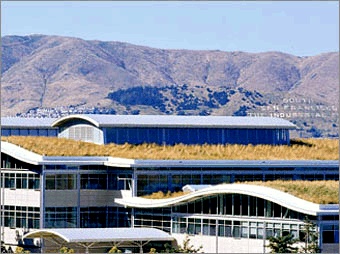The idea of green roof is attractive. In many buildings, roofs are wasted space cover with black asphalt. Why not turn it into something more useful by covering it with soil and grow vegetation on top of it? This will help reduce rain water runoff, urban heat island effect, air-conditioning cost as well as CO2 in the atmosphere.
One great example of green roof project is in the GAP building in San Bruno, California just south of San Francisco. (GAP has since moved out. Google/YouTube is the current tenant.) The office building has sloped roofs that are covered extensively with vegetation. I happen to work in the area and know about the building.
Can green roofs significantly improve the environment? One day I was glancing at an aerial image. I can't help but notice that GAP building's green roof covers only a tiny percentage of the land in San Bruno's office area, as you can see in the green circle I have marked below.

I went ahead and did a little study. I classified the area into four categories: 1) Buildings (red); 2) Natural Area (Green); 3) Parking lot (Yellow); 4) Roads (grey). For simplicity, some small amounts of landscaped areas are counted as parking lot.

I measured the proportion of area of each category as below
- 17% Building
- 10% Natural area
- 55% Parking lot
- 18% Road
In fact buildings only cover 1/6 of land in the area. Roads use as much land as the buildings. Parking lots occupy a staggering 55% of the land. That is over half of the land and three times as much area as the building themselves! Instead of green roof, perhaps what we really need are green parking lots!
Of course this is just one example taken from a suburban environment. And this is not to diminish the value of green design adopted by the GAP building. In fact you can easily see from the picture that GAP uses land far more efficiently that other nearby office complexes. This is just a clear example to me that by far the biggest ecological issue in a suburban commercial space is its extensive asphalt parking lot. And there is probably where designers should spend more effort in greening.
2009.02.14 - comments

